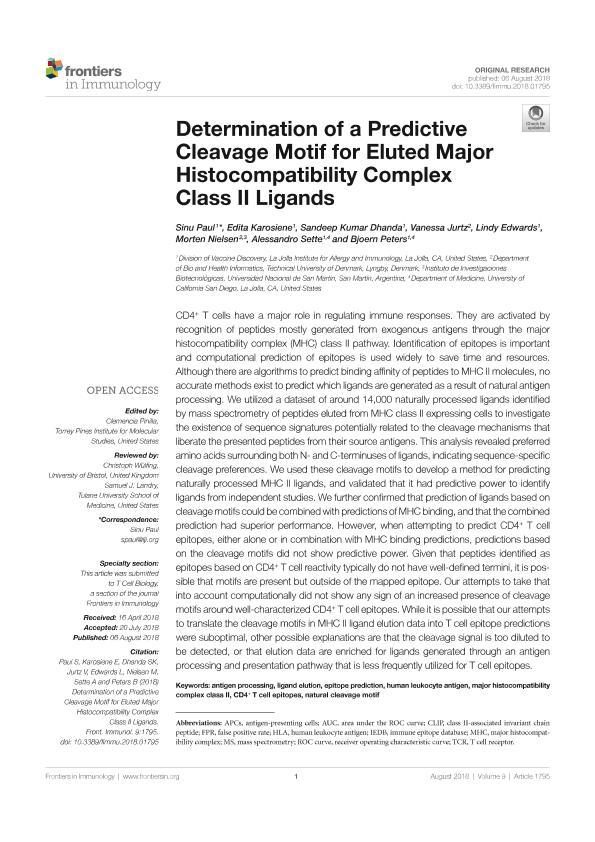Mostrar el registro sencillo del ítem
dc.contributor.author
Paul, Sinu
dc.contributor.author
Karosiene, Edita
dc.contributor.author
Dhanda, Sandeep Kumar
dc.contributor.author
Jurtz, Vanessa
dc.contributor.author
Edwards, Lindy
dc.contributor.author
Nielsen, Morten

dc.contributor.author
Sette, Alessandro

dc.contributor.author
Peters, Bjoern

dc.date.available
2020-02-01T02:46:49Z
dc.date.issued
2018-08
dc.identifier.citation
Paul, Sinu; Karosiene, Edita; Dhanda, Sandeep Kumar; Jurtz, Vanessa; Edwards, Lindy; et al.; Determination of a predictive cleavage motif for eluted major histocompatibility complex class II ligands; Frontiers Media S.A.; Frontiers in Immunology; 9; AUG; 8-2018
dc.identifier.issn
1664-3224
dc.identifier.uri
http://hdl.handle.net/11336/96470
dc.description.abstract
CD4+ T cells have a major role in regulating immune responses. They are activated by recognition of peptides mostly generated from exogenous antigens through the major histocompatibility complex (MHC) class II pathway. Identification of epitopes is important and computational prediction of epitopes is used widely to save time and resources. Although there are algorithms to predict binding affinity of peptides to MHC II molecules, no accurate methods exist to predict which ligands are generated as a result of natural antigen processing. We utilized a dataset of around 14,000 naturally processed ligands identified by mass spectrometry of peptides eluted from MHC class II expressing cells to investigate the existence of sequence signatures potentially related to the cleavage mechanisms that liberate the presented peptides from their source antigens. This analysis revealed preferred amino acids surrounding both N- and C-terminuses of ligands, indicating sequence-specific cleavage preferences. We used these cleavage motifs to develop a method for predicting naturally processed MHC II ligands, and validated that it had predictive power to identify ligands from independent studies. We further confirmed that prediction of ligands based on cleavage motifs could be combined with predictions of MHC binding, and that the combined prediction had superior performance. However, when attempting to predict CD4+ T cell epitopes, either alone or in combination with MHC binding predictions, predictions based on the cleavage motifs did not show predictive power. Given that peptides identified as epitopes based on CD4+ T cell reactivity typically do not have well-defined termini, it is possible that motifs are present but outside of the mapped epitope. Our attempts to take that into account computationally did not show any sign of an increased presence of cleavage motifs around well-characterized CD4+ T cell epitopes. While it is possible that our attempts to translate the cleavage motifs in MHC II ligand elution data into T cell epitope predictions were suboptimal, other possible explanations are that the cleavage signal is too diluted to be detected, or that elution data are enriched for ligands generated through an antigen processing and presentation pathway that is less frequently utilized for T cell epitopes.
dc.format
application/pdf
dc.language.iso
eng
dc.publisher
Frontiers Media S.A.

dc.rights
info:eu-repo/semantics/openAccess
dc.rights.uri
https://creativecommons.org/licenses/by-nc-sa/2.5/ar/
dc.subject
ANTIGEN PROCESSING
dc.subject
CD4+ T CELL EPITOPES
dc.subject
EPITOPE PREDICTION
dc.subject
HUMAN LEUKOCYTE ANTIGEN
dc.subject
LIGAND ELUTION
dc.subject
MAJOR HISTOCOMPATIBILITY COMPLEX CLASS II
dc.subject
NATURAL CLEAVAGE MOTIF
dc.subject.classification
Otras Ciencias de la Salud

dc.subject.classification
Ciencias de la Salud

dc.subject.classification
CIENCIAS MÉDICAS Y DE LA SALUD

dc.title
Determination of a predictive cleavage motif for eluted major histocompatibility complex class II ligands
dc.type
info:eu-repo/semantics/article
dc.type
info:ar-repo/semantics/artículo
dc.type
info:eu-repo/semantics/publishedVersion
dc.date.updated
2019-11-25T17:45:17Z
dc.journal.volume
9
dc.journal.number
AUG
dc.journal.pais
Suiza

dc.journal.ciudad
Lausana
dc.description.fil
Fil: Paul, Sinu. La Jolla Institute for Allergy and Immunology; Estados Unidos
dc.description.fil
Fil: Karosiene, Edita. La Jolla Institute for Allergy and Immunology; Estados Unidos
dc.description.fil
Fil: Dhanda, Sandeep Kumar. La Jolla Institute for Allergy and Immunology; Estados Unidos
dc.description.fil
Fil: Jurtz, Vanessa. Technical University of Denmark; Dinamarca
dc.description.fil
Fil: Edwards, Lindy. La Jolla Institute for Allergy and Immunology; Estados Unidos
dc.description.fil
Fil: Nielsen, Morten. Consejo Nacional de Investigaciones Científicas y Técnicas. Centro Científico Tecnológico Conicet - La Plata. Instituto de Investigaciones Biotecnológicas. Universidad Nacional de San Martín. Instituto de Investigaciones Biotecnológicas; Argentina. Technical University of Denmark; Dinamarca
dc.description.fil
Fil: Sette, Alessandro. University of California at San Diego; Estados Unidos. La Jolla Institute for Allergy and Immunology; Estados Unidos
dc.description.fil
Fil: Peters, Bjoern. La Jolla Institute for Allergy and Immunology; Estados Unidos. University of California at San Diego; Estados Unidos
dc.journal.title
Frontiers in Immunology
dc.relation.alternativeid
info:eu-repo/semantics/altIdentifier/doi/http://dx.doi.org/10.3389/fimmu.2018.01795
dc.relation.alternativeid
info:eu-repo/semantics/altIdentifier/url/https://www.frontiersin.org/articles/10.3389/fimmu.2018.01795/full
Archivos asociados
